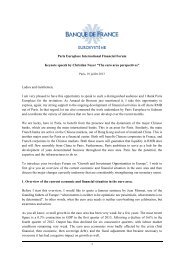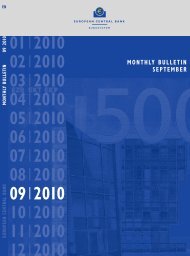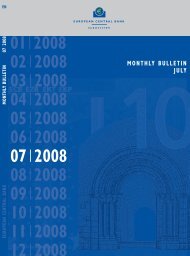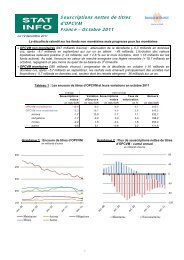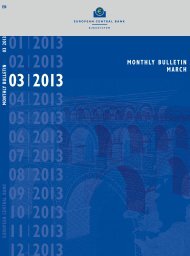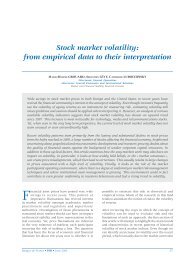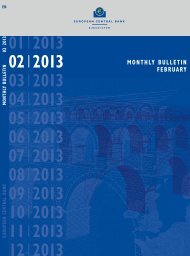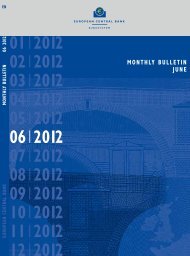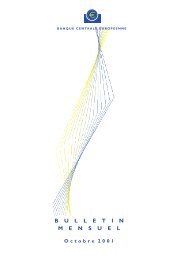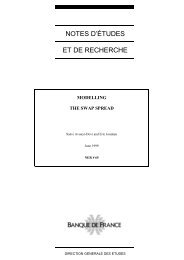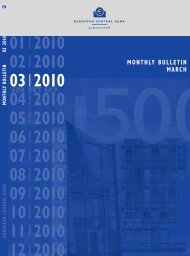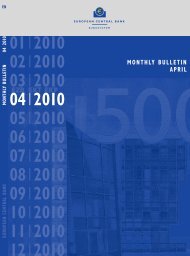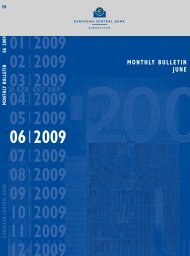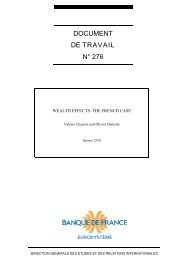Monthly Bulletin July 2009 - Banque de France
Monthly Bulletin July 2009 - Banque de France
Monthly Bulletin July 2009 - Banque de France
You also want an ePaper? Increase the reach of your titles
YUMPU automatically turns print PDFs into web optimized ePapers that Google loves.
ECONOMIC<br />
AND MONETARY<br />
DEVELOPMENTS<br />
Output,<br />
<strong>de</strong>mand and the<br />
labour market<br />
Private consumption contracted by 0.5% (quarter<br />
on quarter) in the first quarter of <strong>2009</strong>. Recent<br />
indicators suggest continued subdued consumer<br />
spending in the second quarter of <strong>2009</strong>.<br />
However, data on retail tra<strong>de</strong> (which makes up<br />
around 45% of consumer spending) showed a<br />
marginal improvement in April, when retail sales<br />
increased by 0.2% compared with one month<br />
earlier. Keeping in mind the volatility of this<br />
series, the April increase was the first positive<br />
monthly growth rate recor<strong>de</strong>d since September<br />
2008. The April increase in retail sales was<br />
broadly based among euro area countries.<br />
Despite the fact that consumer confi<strong>de</strong>nce rose<br />
slightly in May, its persistently low levels are<br />
consistent with weak consumer spending in the<br />
second quarter of <strong>2009</strong> (see Chart 26).<br />
Chart 26 Retail sales and confi<strong>de</strong>nce in the<br />
retail tra<strong>de</strong> and household sectors<br />
(monthly data)<br />
4<br />
3<br />
2<br />
1<br />
0<br />
-1<br />
-2<br />
total retail sales ¹ ) (left-hand scale)<br />
consumer confi<strong>de</strong>nce ² ) (right-hand scale)<br />
retail confi<strong>de</strong>nce ² ) (right-hand scale)<br />
40<br />
30<br />
20<br />
10<br />
0<br />
-10<br />
-20<br />
Looking further ahead, consumption is projected<br />
to remain subdued in the second half of <strong>2009</strong><br />
on account of an expected further <strong>de</strong>terioration<br />
in the labour markets. The recent marginal<br />
improvements in retail sales and consumer<br />
confi<strong>de</strong>nce, however, suggest some stabilisation<br />
in consumer spending. The substantial falls in<br />
commodity prices since last year have supported households’ real disposable income and spending.<br />
Consumer spending has probably also been supported by the implementation of the fiscal packages<br />
adopted in some euro area countries. The extent to which household spending will be stimulated by<br />
the fiscal packages is, however, surroun<strong>de</strong>d by great uncertainty. In<strong>de</strong>ed, the saving ratio in the euro<br />
area has risen in recent quarters.<br />
In line with the pattern observed during previous periods of economic recession, gross fixed capital<br />
formation has been a main driver of the economic downturn. In the first quarter of <strong>2009</strong> gross fixed<br />
capital formation <strong>de</strong>clined by 4.2% (quarter on quarter). Box 5 provi<strong>de</strong>s a more <strong>de</strong>tailed <strong>de</strong>scription<br />
of the current retrenchment in investment.<br />
Investment will probably continue to contribute negatively to economic growth throughout<br />
<strong>2009</strong>. The continued weak outlook for growth in fixed capital formation reflects the expectation<br />
that <strong>de</strong>velopments will be subdued in both non-construction investment (mainly assets inten<strong>de</strong>d<br />
for use in the production of goods and services) and construction investment. The projected<br />
contraction in overall domestic and foreign activity, lower profitability for firms and funding<br />
constraints are factors that will probably weigh on non-construction investment. The same<br />
factors are also expected to dampen construction investment. The ongoing correction of euro<br />
area resi<strong>de</strong>ntial and commercial property prices also suggests subdued construction investment<br />
in the future.<br />
The outlook for investment is also surroun<strong>de</strong>d by great uncertainty. The higher than usual level of<br />
uncertainty mainly results from difficulties in assessing the effects of firms’ worsened financing<br />
conditions and the subdued final <strong>de</strong>mand expected in the quarters ahead.<br />
-3<br />
2004 2005 2006 2007<br />
2008<br />
Sources: European Commission Business and Consumer Surveys<br />
and Eurostat.<br />
Note: Data refer to the euro area including Slovakia.<br />
1) Annual percentage changes; three-month moving averages;<br />
working day-adjusted. Exclu<strong>de</strong>s fuel.<br />
2) Percentage balances; seasonally and mean-adjusted.<br />
-30<br />
ECB<br />
<strong>Monthly</strong> <strong>Bulletin</strong><br />
<strong>July</strong> <strong>2009</strong><br />
49




